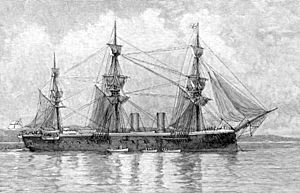HMS Inconstant (1868)

HMS Inconstant about 1885
|
|
| Class overview | |
|---|---|
| Succeeded by: | HMS Shah |
| Completed: | 1 |
| Scrapped: | 1 |
| History | |
|
|
|
| Name: | Inconstant |
| Builder: | Pembroke Dockyard |
| Laid down: | 27 November 1866 |
| Launched: | 12 November 1868 |
| Commissioned: | 14 August 1869 |
| Renamed: |
|
| Reclassified: |
|
| Fate: | |
| Class overview | |
| Succeeded by: | HMS Shah |
| Completed: | 1 |
| Scrapped: | 1 |
| General characteristics | |
| Type: | Unarmored steam frigate |
| Tonnage: | 4,066 bm |
| Displacement: | 5,782 long tons (5,875 t) |
| Length: | 337 ft 4 in (102.8 m) (p/p) |
| Beam: | 50 ft 4 in (15.3 m) |
| Draught: | 25 ft 6 in (7.8 m) |
| Installed power: | |
| Propulsion: | 1 shaft; 1 × trunk steam engine |
| Sail plan: | Ship rig |
| Speed: | 16 knots (30 km/h; 18 mph) |
| Range: | 2,780 nmi (5,150 km; 3,200 mi) at 10 knots (19 km/h; 12 mph) |
| Complement: | 600 |
| Armament: | |
HMS Inconstant was an unarmored, iron-hulled, screw frigate built for the Royal Navy in the late 1860s. Upon completion in 1869, she was the fastest warship in the world and was assigned to the Channel Squadron. Two years later the ship was transferred to the Detached Squadron for a brief time before she was paid off into reserve in 1872. Inconstant was recommissioned in 1880 for service with the Flying Squadron that circumnavigated the world in 1880–82. On the return voyage, the ship was diverted to Egypt during the Anglo-Egyptian War of 1882 and played a minor role supporting operations ashore. She was reduced to reserve again after her return and was served as an accommodation ship in 1897. Inconstant was hulked in 1904 and became a training ship in 1906. She continued in that role, under a variety of names, until she was sold for scrap in 1955 and subsequently broken up, the second-to-last surviving Pembroke-built warship in existence.
Inconstant was the first of six fast, unarmoured, iron-hulled, frigates designed by the Director of Naval Construction, Sir Edward Reed, in response to the fast, wooden American Wampanoag-class frigates. Only three were built, however, as the American ships proved to be flawed enough to pose no real threat and the British ships were very expensive. The ship was 337 feet 4 inches (102.8 m) long between perpendiculars, had a beam of 50 feet 3 inches (15.3 m), and a draught of 25 feet 6 inches (7.8 m). Inconstant displaced 5,780 long tons (5,870 t) and had a tonnage of 4,066 tons burthen. She carried a complement of 600 officers and ratings. To reduce biofouling, her iron hull was sheathed in two layers of oak 3 inches (76 mm) thick that was covered by a layer of copper. Inconstant was a good seaboat and a steady gun platform.
...
Wikipedia
